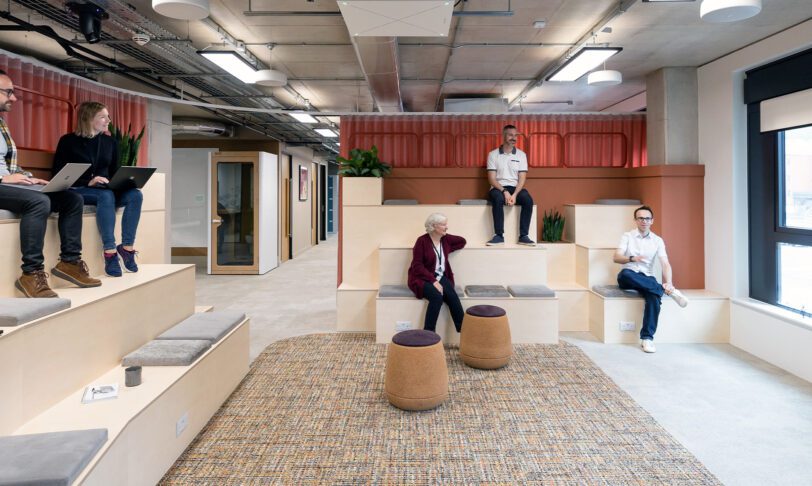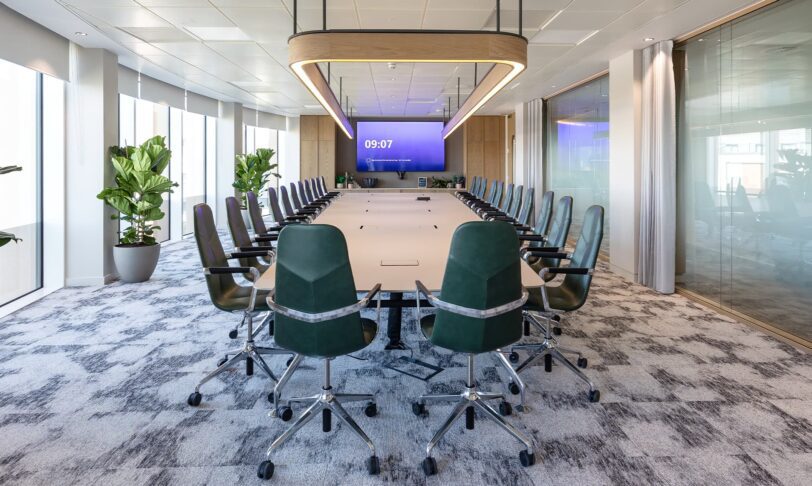Why is workplace engagement important?
The concept of workplace engagement has generated a great deal of interest from scholars, business leaders, and governments since the term was first coined in 1990. Despite this, certain misconceptions about workplace engagement still proliferate. With over thirty years of workplace strategy expertise, we’re here to share how you can effectively implement an engagement strategy within your business and see results.
For instance, it can be easy to assume that workplace engagement is synonymous with common metrics such as job satisfaction, motivation or productivity. In fact, employee engagement can be defined as the extent to which employees understand their role in helping an organisation reach its long-term goals. In other words, they are fully on board with what an organisation is trying to achieve and have a vested interest in making this vision a reality.
It’s also important to point out that there’s a marked difference between initiatives that increase engagement and those that decrease disengagement. This may sound a touch pedantic, but hear us out. You may have heard of Frederick Herzberg’s influential Motivator-Hygiene theory. This theory distinguishes between two core elements of employee satisfaction: internal “Hygiene Factors” that decrease dissatisfaction such as salary and working conditions, and external “Satisfaction Motivators” which, as the name suggests, increase satisfaction. These include opportunities for personal growth and being recognised for achievements. While we’ve pointed out that job satisfaction and engagement are two separate concepts, we think this theory can help leaders understand whether they’re going the extra mile to create engaging workplaces or simply delivering what’s to be expected.
You can delve further into this subject with our workplace culture whitepaper, but we’re getting ahead of ourselves a little…
Engagement acts as the source of energy that fuels motivation and productivity. It’s the spark that encourages employees to go the extra mile, throwing themselves wholeheartedly into their work.
In this article, we’ll be delving into exactly what workplace engagement looks like, and how companies can increase engagement by turning their workplace into somewhere that motivates and inspires people.

How can increased workplace engagement see growth for your business?
As you’d expect, the benefits of workplace engagement include a workforce that is proud of its contribution to the organisation, with employees showing their eagerness to contribute new ideas and perform at their very best. And, since they love their jobs and their workplace, they aren’t as likely to move on to pastures new.
Their positive feelings are infectious too – all that enthusiasm has its effect on those around them and the overall business culture. Looking for fresh, creative ideas? With their focus on helping your business to be the best it can be, engaged employees will be eager to share their thoughts and inspirations.
In short, a genuinely engaged employee is a satisfied, highly-motivated person who will do everything in their power to be an asset to your business while still maintaining a healthy work-life balance.
Not convinced yet? Here are just a few stats about the benefits of workplace engagement:
- The companies with the highest rates of workplace engagement are 21% more profitable
- Companies with actively engaged employees see an 18% reduction in staff turnover
- Organisations with a highly engaged workforce can expect up to a 17% increase in productivity
What factors contribute to workplace engagement?
When it comes to enhancing workplace engagement, helping employees to understand and support goals and strategies is a good start. We all like to work on something we can believe in and that we think matters. One of the main ways people become disengaged is when they become unsure as to whether their work serves any kind of overarching purpose.
Good leadership at the coalface matters too. When managers provide support in solving day-to-day challenges, are ready and willing to understand employees as individuals, and are ready to roll up their sleeves and get involved, employees care about their success and want to support them in reaching organisational goals.
Listening to employees and providing feedback is vital to the promotion of employee engagement. A 2018 McLeod report notes that “employee voice” is among the most important factors in workplace engagement. When people feel valued in the workplace, they’re ready to deliver value in return.
Opportunities for personal and professional growth also contribute to engagement, as do recognition and rewards. However, researchers say that material rewards can be great for morale, but may not do much in terms of helping people understand how their work serves a greater purpose.
On the other hand, non-material rewards, even just the simple act of thanking employees for their contributions to the company, can go a long way toward fostering engagement. Opportunities for bettering themselves by learning new skills ensure that people feel as though they are growing alongside the organisation. Here at Interaction, we use HiBob to give Kudos to our colleagues for a range of reasons, from being the front-runner in delivering a great project to going above and beyond to help someone.
With skilled employees performing jobs they understand well, it’s easy for businesses to allow them to get on with their work. If they know the desired outcome, they can decide on how they’ll get there. Being trusted to work autonomously is a real engagement booster. In a similar vein, providing the resources and facilities employees need to give their best empowers them to do just that.
Finally, there’s the social side of things. Having good relationships with colleagues and managers, and even having a bit of fun at work, makes the workday routine something to look forward to.
Boost your business by implementing engagement into your workplace strategy

Ensure that workplace engagement comes from the top
Effective employee engagement in the workplace is a top-down phenomenon. Consider your business’s values to ensure that they’re meaningful, inspiring, and implemented as standard practice. The narrative and values that lie behind the business itself can be a strong contributor to workplace engagement – provided they reflect realities.
To drive your strategy, you will need engaged leaders and managers who are committed to your initiative. Some extra training may be necessary to help them understand what you’re trying to achieve and why an engaged workforce is so important.
Be proactive in eliciting employees’ perspectives and feedback
Leaders need to understand how people feel about their work. What do they enjoy about the work they do? What are the obstacles to engagement that leave them feeling neutral or even completely disengaged? The best way to find out is to ask the right questions and get honest answers. You can appoint third-party researchers or consultants, but you can also conduct anonymous surveys or hold company-wide ‘town hall’ meetings in which employees are encouraged to share their experiences and opinions.
You should also explore ways to make the physical workplace – its buildings and offices – conducive to engagement. Post-occupancy evaluation is a useful tool in this regard. Do your physical facilities contribute to workplace engagement, or do they act as a source of frustration instead? It can be hard to do this evaluation as an insider. Get a fresh pair of eyes to help you spot ways to enhance your offices so people have what they need to get their job done to the best of their abilities.
Many businesses these days use a hybrid workplace approach. It can be very effective in fostering engagement, but improving employee engagement in a hybrid workplace takes careful attention to the employee experience on the days when they report in. Ensure that you can offer a ‘destination’ workspace that has tangible benefits for employees, rather than simply trying to lure people into a space that doesn’t offer anything they can’t get at home.

Investing in a workplace engagement strategy
Your commitment to improved workplace engagement is as important as your buy-in to any other strategic drive you undertake. And, as with other initiatives, being in the thick of things can be both a help and a hindrance. Sometimes, it can be hard to see the wood for the trees, so getting expert help can make an all-important difference to the results you’ll achieve.
It’s not just about having happy employees. The importance of engagement in the workplace can’t be overstated. When everybody is eager to give their best, you get the best results. Researchers agree that engaged employees mean better organisational outcomes.
Eager to find out more? Read Nita Clarke and David MacLeod’s “Engaging for Success” for a thorough insight, including commentary from some of the UK’s leading organisations.
Ultimately, your approach to workplace engagement should be well-considered and tailored to match your circumstances. Engagement requires the right setting – workplaces that are strategically designed so that people can do their best work and actively contribute to their organisation’s goals, while also maintaining an optimal work-life balance. This is something that our workplace strategy consultants specialise in.
Find out more about how we can help your workplace reach its goals. Get in touch at 01225 485 600 or why not schedule a chat with Charlie?



